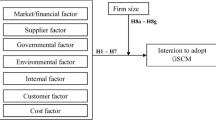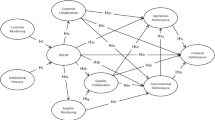Abstract
Today, in advanced companies, the supply chain managers have attempted to use green logistics in order to improve the environmental performance in the whole supply chain. This could be taken as a strategic key to achieve the stable competitive advantage. Based on an environmental perspective, the Supply Chain Performance (SCP) can be enhanced through making utility and satisfaction for stakeholder. The purpose of the present study is to evaluate the impacts of Green Supply Chain Management (GSCM) practices on economic, environmental, and operational performance in Iranian automobile industry by using a Structural Equation Modeling (SEM). To do so, a model with four hypotheses has been proposed which illustrates the relationship between GSCM practices and SCP in terms of their indices. GSCM practices include four factors: the supplier management, the product recycling, the organizational involvement, and the product lifecycle management. In addition, SCP includes four aspects, namely the environmental performance, the positive economic performance, the negative economic performance, and the operational performance. To collect data in the practical area, questionnaires and field researches were used, then the proposed model has been analyzed and confirmed by applying Pearson Correlation Coefficient and SEM. The confirmation of the research hypotheses showed that the improvement of GSCM practices in Iranian automobile industry has positively promoted the SCP with the prediction rate of 70.56% and in the 95% confidence level. After implementing this model in Saipa automobile company as a case study cooperating with more than 1000 suppliers, the decision processes were enhanced so as to create sustainable value chain, develop opportunities for customers, produce sustainable benefits for both shareholders and employees regarding the organization involvement, the product lifecycle management, the product recycling and the suppliers management. Using this model, the Iranian automobile companies’ managers also manage effectively to create sustainable values for stakeholders through creating positive economical, operational and environmental impacts on its own value chain performance.







Similar content being viewed by others
Change history
11 August 2018
The original PDF version of this article unfortunately contains error introduced during the production process. The Publisher apologizes for this error. The fifth paragraph under “Conclusions and suggestions” section was not properly formatted. The correct paragraph is now given below.
References
La Rovere RL (1996) IT diffusion in small and medium-sized enterprises: elements for policy definition. Inf Technol Dev 7(4):169–181
Morash EA, Lynch DF (2002) Public policy and global supply chain capabilities and performance: a resource-based view. J Int Mark 10(1):25–51
Boks C, Stevels A (2007) Essential perspectives for Design for Environment. Experiences from the electronic industry. Int J Prod Res 45(18–19):4021–4039
Birou, L M Fawcett, S E & Magnan, GM (1998). The product life cycle: a tool for functional strategic alignment. J. Supply Chain Manag. 34(1), 37-52.
Stonebrake PW, Liao J (2006) Supply chain integration: exploring product and environmental contingencies. Supply Chain Manag: An International Journal. 11(1):34–43
Hu, A.H. and Hsu, C. (2010), Critical factors for implementing green supply chain management practice: An empirical study of electrical and electronics industries in Taiwan Management Research Review, Vol. 33 No. 6, and pp. 586–608
Zhu Q, Sarkis J, Lai KH (2007) Green supply chain management: pressures, practices and performance within the Chinese automobile industry. J Clean Prod 15(11):1041–1052
Ahi P, Searcy C (2015) An analysis of metrics used to measure performance in green and sustainable supply chains. J Clean Prod 86:360–377
Youn S, Yang MGM, Hong P, Park K (2013) Strategic supply chain partnership, environmental supply chain management practices, and performance outcomes: an empirical study of Korean firms. J Clean Prod 56:121–130
Gopal PRC, Thakkar J (2016) Sustainable supply chain practices: an empirical investigation on Indian automobile industry. Prod Plan Control 27(1):49–64
Momeni M, Monavarian A, Shaabani E, Ghasemi R (2011) A conceptual model for knowledge management process capabilities and core competencies by SEM the case of Iranian automotive industry. Eur J Soc Sci 22(4):473–489
Samani, M. B., Attafar, A., & Khouzani, N. K. (2011). A conceptual model for Iran’s car industry customers’ loyalty. In proceedings of the 2nd international conference on business and economic research (2nd ICBER 2011)
Govindan K, Khodaverdi R, Vafadarnikjoo A (2015) Intuitionistic fuzzy based DEMATEL method for developing green practices and performances in a green supply chain. Expert Syst Appl 42:7207–7220
IARC 2017: New trends in automobile recycling
Directive 2005/64/EC of the European Parliament and of the Council of 26 October 2005 on the type-approval of motor vehicles with regard to their reusability, recyclability and recoverability and amending Council Directive 70/156/EEC
Barros AI, Dekker R, Scholten V (1998) A two-level network for recycling sand: a case study. Eur J Oper Res 110(2):199–214
Bras B, McIntosh MW (1999) Product, process, and organizational design for remanufacture–an overview of research. Robot Comput Integr Manuf 15(3):167–178
Gungor A, Gupta SM (1999) Issues in environmentally conscious manufacturing and product recovery: a survey. Comput Ind Eng 36(4):811–853
Van der Laan E, Dekker R, Salomon M, Ridder A (1996) An (s, Q) inventory model with remanufacturing and disposal. Int J Prod Econ 46:339–350
Srivastava SK (2007) Green supply‐chain management: a state‐of‐the‐art literature review. Int. J Manag Rev. 9(1):53–80
Vachon, S. & K. Klassen, (2006): Extending Green Practices across the Supply Chain, International Journal of Operations & Production Management, 795–821
Hervani, A., Helms, M., & J. Sarkis, (2005): Performance Measurment for green supply chain, Benchmarking: An Intermational Journal, 330–353
Darnall, N., Jolley, G. J., & Ytterhus, B. (2007). Understanding the relationship between a facility's environmental and financial performance
Zhang HC, Kuo TC, Lu H, Huang SH (1997) Environmentally conscious design and manufacturing: a state-of-the-art survey. J Manuf Syst 16(5):352–371
Al-Tuwaijri, S. A., Christensen, T. E., & Hughes, K. E. (2004). The relations among environmental disclosure, environmental performance, and economic performance: a simultaneous equations approach. Acc Organ Soc, 29(5), 447–471 Chicago
Zhu Q, Sarkis J (2006) An inter-sectoral comparison of green supply chain management in China: drivers and practices. J Clean Prod 14(5):472–486
Zhu Q, Sarkis J (2007) The moderating effects of institutional pressures on emergent green supply chain practices and performance. Int J Prod Res 45(18–19):4333–4355
Tsoulfas GT, Pappis CP (2006) Environmental principles applicable to supply chains design and operation. J Clean Prod 14(18):1593–1602
Zhu Q, Geng Y, Lai KH (2010) Circular economy practices among Chinese manufacturers varying in environmental-oriented supply chain cooperation and the performance implications. J Environ Manag 91(6):1324–1331
Kuei CH, Madu CN, Chow WS, Chen Y (2015) Determinants and associated performance improvement of green supply chain management in China. J Clean Prod 95:163–173
Kusi-Sarpong S, Sarkis J, Wang X (2016) Green supply chain practices and performance in Ghana's mining industry: a comparative evaluation based on DEMATEL and AHP. Int. J. Bus Performance and Supply Chain Modelling 8(4):320–347
Geng R, Mansouri SA, Aktas E (2017) The relationship between green supply chain management and performance: a meta-analysis of empirical evidences in Asian emerging economies. Int J Prod Econ 183:245–258
Pearson ES (1938) Mathematical statistics and data analysis, 2nd edn. Duxbury, Belmont
Taylor R (1990) Interpretation of the correlation coefficient: a basic review. J Diagn Med Sonogram 6(1):35–39
Hoyle RH (1995) The structural equation modeling approach: basic concepts and fundamental issues. In: Hoyle RH (ed) Structural equation modeling: concepts, issues, and applications. Sage Publications, Thousand Oaks, pp 1–14
Baumgartner, H., & Weijters, B. (2017). Structural equation modeling. In advanced methods for modeling markets (pp. 335–360). Springer, Cham
Cronbach LJ (1951) Coefficient alpha and the internal structure of tests. Psychometrika 16:297–334
Lawshe CH (1975) A quantitative approach to content validity. Pers Psychol 28(4):563–575
Waltz, C. F., & Bausell, B. R. (1981). Nursing research: design statistics and computer analysis. Davis FA
Kline, P. (2014). An easy guide to factor analysis. Routledge
Chiappelli F (2014) Fundamentals of evidence-based health care and translational science, vol 18. Springer, Heidelberg
Thompson, B. (2004). Exploratory and confirmatory factor analysis: understanding concepts and applications. American Psychological Association
Cerny CA, Kaiser HF (1977) A study of a measure of sampling adequacy for factor-analytic correlation matrices. Multivar Behav Res 12(1):43–47
Bartlett MS (1950) Tests of significance in factor analysis. Br J Math Stat Psychol 3(2):77–85
Hwang CL, Yoon K (1981) Methods for multiple attribute decision making. In multiple attribute decision making. Springer, Berlin, Heidelberg, pp 58–191
Wright R, Elcock K (2006) The RoHS and WEEE directives: environmental challenges for the electrical and electronic products sector. Environ Qual Manag 15(4):9–24
Author information
Authors and Affiliations
Corresponding author
Appendix
Appendix
Rights and permissions
About this article
Cite this article
Aalirezaei, A., Esfandi, N. & Noorbakhsh, A. Evaluation of relationships between GSCM practices and SCP using SEM approach: an empirical investigation on Iranian automobile industry. Jnl Remanufactur 8, 51–80 (2018). https://doi.org/10.1007/s13243-018-0045-y
Received:
Accepted:
Published:
Issue Date:
DOI: https://doi.org/10.1007/s13243-018-0045-y




